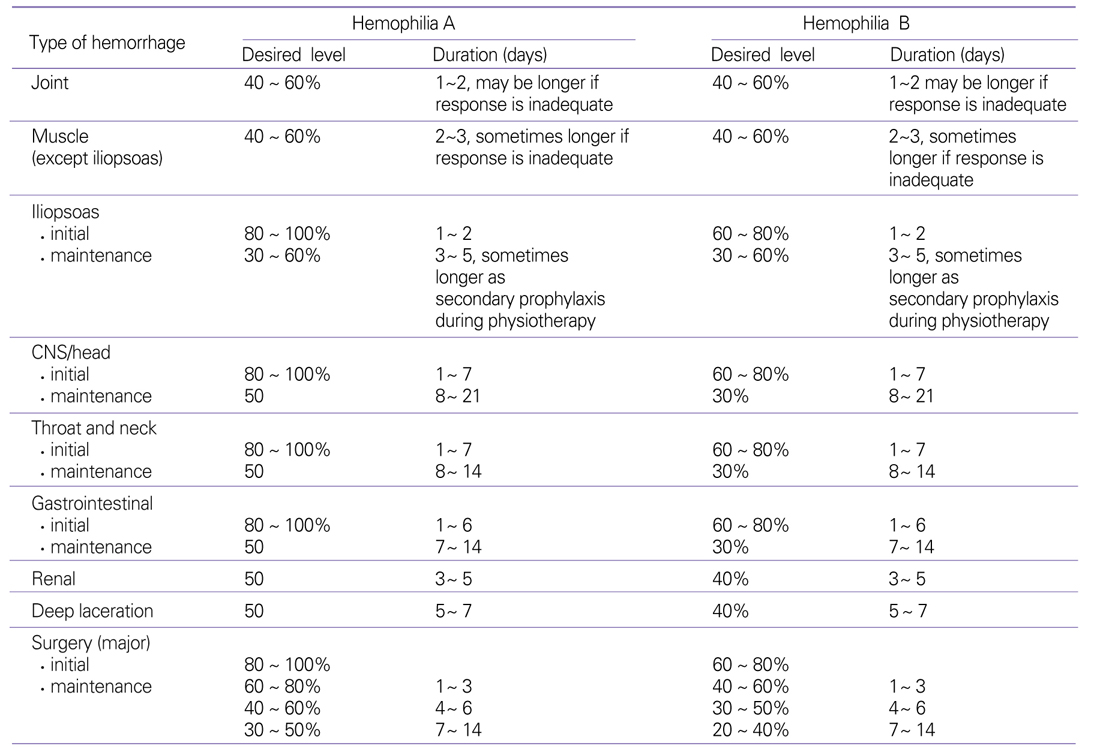 |
 |
- Search
| J Korean Med Assoc > Volume 50(9); 2007 > Article |
Abstract
The management of hemophilia patients includes the treatment of acute bleeding, prevention of bleeding, and the treatment of complications. Bleeding can be minimized by prophylactic factor maintenance, education, and lifestyle modifications. The complications in hemophilia include hemophilic arthropathy, inhibitor development, liver disease due to transfusion-transmitted infections, etc. Patients can be managed ideally in comprehensive hemophilia care centers. The management of bleeding is most important. Treatment should be given early with an appropriate amount of drugs, according to the extent and site of bleeding. This early treatment is possible by home therapy. Life-threatening bleedings such as bleeding of the central nervous system, throat, or neck should be treated as emergency, immediately before evaluation. Recently, the World Federation of Hemophilia published a guideline for the management of hemophilia, which also suggested a good standard for the care of bleeding patients. In this article, the author introduce coagulation factors available in Korea for the treatment of hemophilia patients, including bypassing agents for inhibitor patients, and discuss practical points for the treatment of hemophilia patients in Korea.
References
1. Lozier JN, Kessler CM. In: Hoffman R, Benz EJ, Shattil SJ, Furie B, Cohen HJ, Silberstein LE, McGlave P, editor. Clinicl aspects and therapy of hemophilia. Hematology, Basic Principles and Practice 2005;4th ed. Philadelphia: Elsevier Churchill Livinstone. 2047-2069.
2. World Federation of Hemophilia. Treatment of Bleeding in Hemophilia. Guidelines for the management of Hemophilia 2005;Montreal: World Federation of Hemophilia. 37-44.
3. World Federation of Hemophilia. Plasma Factor Level and Duration of Administration. Guidelines for the management of Hemophilia 2005;Montreal: World Federation of Hemophilia. 45-46.
4. White GC, Rosendaal F, Aledort LM, Lusher JM, Rothschild C, Ingerslev J. Definitions in Hemophilia: Recommendation of the Scientific Subcommittee on Factor VIII and Factor IX of the Scientific and Standardization Committee of the International Society on Thrombosis and Haemostasis. Thromb Haemost 2001;85:560.
5. Feinstein DI. In: Hoffman R, Benz EJ, Shattil SJ, Furie B, Cohen HJ, Silberstein LE, McGlave P, editor. Inhibitors in hemophilia. Hematology, Basic Principles and Practice 2005;4th ed. Philadelphia: Elsevier Churchill Livinstone. 2071-2080.
6. Hay CRM, Brown S, Collins PW, Keeling DM, Liesner R. The diagnosis and management of factor VIII and IX inhibitors: a guideline from the United Kingdom Haemophilia Centre Doctors Organisation. Br J Haematol 2006;133:591-605.
7. Astermark J, Donfield SM, DiMichele DM, Gringeri A, Gilbert SA, Waters J, Berntorp E. A randomized comparison of bypassing agents in hemophilia complicated by an inhibitor: the FEIBA NovoSeven Comparative (FENOC) Study. Blood 2007;109:546-551.
- TOOLS
-
METRICS

-
- 4 Crossref
- Scopus
- 1,053 View
- 4 Download
-
Related articles in
J Korean Med Assoc -
Treatment of advanced heart failure2022 January;65(1)
Treatment of diabetic foot ulcers2021 August;64(8)
Surgical treatment of lymphedema2020 April;63(4)
Treatment of Adult Bronchial Asthma1997 March;40(3)
Treatment and Prognosis of Encephalitis in Children1997 July;40(7)






